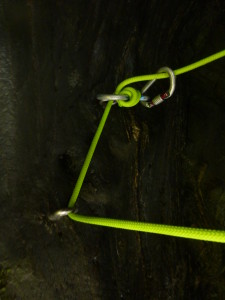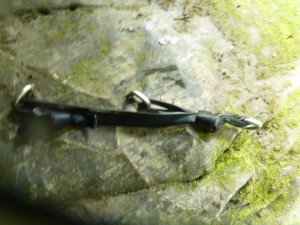Taken from a post on the KiwiCanyons.org Facebook Page
Thanks for lots of good discussion points!
Whilst many of the very fine observations such as torquing of the eye bolt, slightly short tails, orientation of the sling towards the pitch are valid, the main thing I wanted to get to was that the sling is completely unnecessary.
As Andrew, Oli and Richard point out, these eye bolts are intended to be used with the rope running directly through them.
The disadvantage is that eventually the rope retrieval will wear the bolts, but this is outweighed by numerous advantages…
Firstly, there’s no component (sling) that needs to be replaced.
Second, there’s nothing that can thrash around if the anchors ever have flow over them. (In Europe, they have frequently observed that water has the relentless energy to loosen bolts if they are in/near the flood/flow levels)
Finally, 2x Glue in bolts are incredibly strong. Placing webbing and a link actually decreases the overall strength of that anchor.
Each 10mm glue in bolt is rated to 35kN (yes, more than your descender karabiner @ 22kN and more than your 9mm rope at 22.15kN)
http://www.accessgear.net/products-page/rope-and-webbing/kordas-dana-9mm-canyoning-rope-pm/
http://www.petzl.com/en/Professional/Anchors/COLLINOX?l=INT#.VMp68mjQrTZ
However, even 25mm tubular climbing webbing is only rated to 18kN..
http://www.accessgear.net/products-page/rope-and-webbing/tubular-webbing/
Depending on which internet site you ‘research from’ water knots reduce the strength of webbing to 60-40% of untied webbing.
http://slacklab.de/en/rigging/strength-of-webbing-anchors
So with the pictured set up, even if we ignore the water knot joining the sling, but consider the water knot at the master point;
4 strands of 18kN = 72kn, x 40% = 28.8kN
Which is less than one of the glue in anchors…
Or if you consider the link (hard to tell what this actually is in the photo) but it takes a stainless 8mm maillion rapide to reach 35kN…
http://www.accessgear.net/products-page/karabiners-and-screwlinks/maillon-rapide-screwlink-oval-8mm/
So, basically by adding webbing/link, the user has probably weakened the overall strength of the system, cost themselves nearly $10, introduced the possibility of rigging error, and has now left an anchor that people will be tempted to use (rather than replace as the webbing degrades in UV light..)
So what can you do instead?
Simply thread the rope through the eyes! If you want to use a releaseable system, put a figure 8 releaseable on the top bolt. If you want to ‘equallise’ the bolts, then put a quickdraw between them and rig off the lower bolt.

This set up is releaseable, retrieveable and rated to 35kN….
And whilst you’re threading these bolts, take time to think about the cost/effort/patience required by the person who placed them… (click the ‘technical info button)
http://www.fixehardware.com/shop/glue-in-bolts/fixe-ss-10mm-x-8cm-glue-in-bolt/
Or take the time to wonder how many kN that tree, boulder pinch or chockstone is rated to…









Thanks for posting this! I agree with your conclusions but… I don’t think that a 35kN anchors is safer than a 10kN anchor. I would consider both 100% safe for any expected load, including 2-3 person rescues. I would probably add the sling using rope and a rap-ring if I were in a high traffic canyon. Cheers!
Very nice article! Very informative. Thank you Daniel!
Brilliant article thanks! Very logical. I am forever appreciative for the cost effort and patience it takes for people to install bolts. Thankyou!